By Mitchel Townsend
IN 1967, Roger Patterson and Robert Gimlin spotted, and filmed, or so they claimed, a Sasquatch next to Bluff Creek in California. Dubbed an elaborate hoax by many, this image has become the universal symbol for Bigfoot throughout the United States. But, is Bigfoot real? A better question would be to ask why mainstream science has failed to put the question to the test when it comes to not only Bigfoot, but to other cryptids as well. Science is duty-bound by definition to explain the unexplained, yet some people are still debating the existence of Bigfoot rather than examining emerging scientific evidence, some of which has come to light in unexpected places.
![]() Iconic frame 352 from the Patterson-Gimlin film which gave a face to the now popular cryptid creature known as Bigfoot. Despite emerging evidence, people continue to ask: Is Bigfoot real? (Bob Gimlin / YouTube)
Iconic frame 352 from the Patterson-Gimlin film which gave a face to the now popular cryptid creature known as Bigfoot. Despite emerging evidence, people continue to ask: Is Bigfoot real? (Bob Gimlin / YouTube)
New Bigfoot Evidence from Washington State: Tooth and Bite Marks
One of these places is Mount St. Helens in Washington State. In 2013 and 2014, along with one of my former college students, I located three different ungulate rib prey bone assemblages (elk and deer rib bones) that had seemingly inexplicable chewing marks left in them. We conducted a two year Zooarcheological field research project, which culminated at the 69th Annual Anthropological Research Conference on March 26, 2016.
Why the Patterson-Gimlin Bigfoot Film Should Concern Scholars of Human Origins
The Oldest Bigfoot Photo: A Cryptozoology Conspiracy?
At the conference I presented our conclusions to a room full of respected academic and governmental anthropologists and archeologists, in the form of incisor, molar and pre-molar dental signature evidence that we were able to very carefully link with current scientific literature describing historical and contemporary hominin chewing evidence. This published, peer-reviewed literature described a diagnostic framework for accurately separating and identifying hominin mastication evidence recovered from both pre-archaic sites and comparative contemporary chewing studies upon ungulate rib bones.
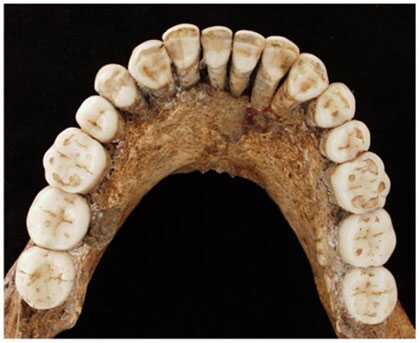 Fossil jaw of Neanderthal. (P Sémal /Royal Belgian Institute of Natural Sciences)
Fossil jaw of Neanderthal. (P Sémal /Royal Belgian Institute of Natural Sciences)
Rib Peeling as Evidence of Hominin Mastication
The Pre-Molar and Molar dentition signature evidence analysis is perhaps the strongest indication of hominin mastication evidence that emerged from the field research. The current peer-reviewed scientific literature describes Rib Peeling as a clear hominin assigned bone surface modification diagnostic characteristic. The physical act of rib peeling entails putting a rib in a hominins mouth and using their hands as levers to move the rib in cooperation with using their pre-molars and molars to masticate the ends.
This specific force application procedure has been evaluated over several peer-reviewed studies both pre-archaic and contemporary as clearly diagnostic of hominin mastication activity. This process creates specific secondary dentition signatures in consistent hemispherical regions of masticated ungulate rib specimens. The pre-molar impressions were triangular in shape while the molar evidence is characterized by double arch shapes. The evidence recovered from all three sites demonstrated clear and consistent rib peeling evidence.
The physical act or process of Rib Peeling is very simple. It consists of using your hands to put a rib in your mouth and using those same hands to move the end of the rib around as you chew on the opposite end. This creates very specific damage and tooth marks in predictable locations on a rib. It also creates secondary tooth marks in expected locations. This predictable combination of damage and individual teeth mark impression evidence is clearly supported in current scientific research and is an accurate tool that enables the separation of hominin verses predator chewing evidence in bones.
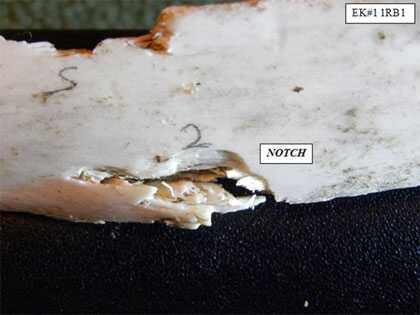 As part of Bigfoot-related evidence presented at the 2016 conference, Mitchel Townsend presented a new category of incisal dentition signature termed “a notch.” (Author provided)
As part of Bigfoot-related evidence presented at the 2016 conference, Mitchel Townsend presented a new category of incisal dentition signature termed “a notch.” (Author provided)
Hominin Mastication Activity Discovered on Bones
Furthermore, we proposed the evaluation of a new category of incisal dentition signature termed a “notch,” which consolidated the applicable literature and accurately described some of our field research evidence. The conference gave us a chance to demonstrate the links between the tooth marks that we recovered in the field, with current peer reviewed scientific research covering the same subject. This current research provided a framework by which we could compare our tooth mark descriptions. It also helped provide a very effective tool that enables scientists to re-examine other suspected human chewing evidence upon bones.
All three locations contained the same evidence profiles of ungulate (deer and elk) rib evidence with clear and measurable evidence of hominin mastication activity. The dentition of other known local ecosystem specific predators and scavengers was compared against Homo sapiens dentition. Of the 25 total hominin incisor measurements taken from all three sites, 92% are outside the average lateral incisors size range for modern Homo sapiens . In this same sample, 80% are outside the average measurement for central incisor. From this evidence, Upper Inter-Canine measurements can be accurately estimated. All of the comparative analysis demonstrated hominin dentition physio-morphology of at least two times the size of modern humans.
The evidence was clear and consistent across all three locations. The teeth marks and jaw shapes of bear, cougar, humans, porcupine, and wolverine along with every other potential species that might have been responsible was examined and eliminated or included. After identifying the teeth marks as Hominin, we measured the geometry of the individual marks and were able to determine that they were primarily outside the upper size range for current humans. From these measurements we were able to estimate mouth size, which again was over double the size of a modern human.
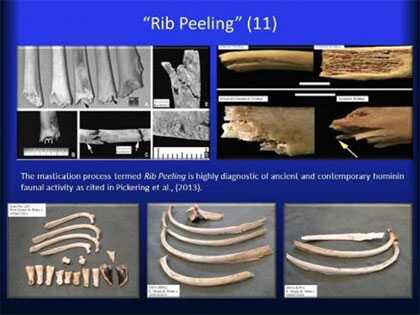 Rib Peeling. (Author provided)
Rib Peeling. (Author provided)
Bone Stacking and Other Hominin Behavior
Behavioral evidence analyzed from each site supported the forensic evidence. A review of the applicable scientific literature also demonstrated that ungulate ribs were a central and connecting theme. We have proposed the addition of three behavioral manifestations or categories illuminated by the neoichnological analysis of the supplementary data. All three are fundamentally connected to ungulate rib mastication evidence.
Another Bigfoot Quest, Another Shaky Video
Is There Archaeological Evidence of Bigfoot?
The first is called Bone Stacking and has a very long history in hominin evolution. In the case of our data, bone stacking was present at all three locations. We propose and the literature supports the assertion that hands are required to accomplish this behavior. The second revolves around prey of choice. Ungulate ribs were statistically the most prevalent bone evidence preservation medium recorded in all of the literature examined. Contemporary chewing studies initiated to understand hominin mastication strategies have all produced ungulate rib evidence in alignment with pre-archaic studies. The overall prevalence of this type of bone evidence modification medium is a central theme throughout the literature and the field evidence recovered from Mount St. Helens.
The final behavioral expression that we illuminated centered upon the behaviors associated with Rib Peeling. Rib Peeling is a behavioral act that requires hands to accomplish. As previously described it requires putting a rib in a hominins mouth and using hands as levers to help apply additional forces during mastication activity. This association of hands and rib peeling is clearly supported in the literature and the analyzed field data. The central themes throughout that emerged were the statistically high incidence of ribs, the requirement of hands, and the assignment of associated dentition evidence coordinated with behavioral evidence as a reliable diagnostic framework for assessing potential hominin attributed mastication activity in bones.
Humans throughout time have behaved in certain predictable ways when selecting food and processing these foods. The accurate coordination of physical evidence with behavioral evidence is a well-developed field in criminal science. We were able to demonstrate a clear connection throughout our research with the physical evidence. This connection was clearly centered upon the use of hands, eating in a predictable manner, and selecting ungulate species as a primary food source.
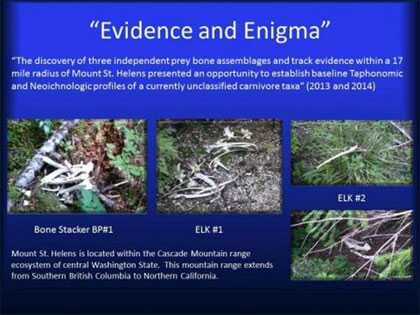 Bone stacker evidence presented. (Author provided)
Bone stacker evidence presented. (Author provided)
What Does It All Mean? Is Bigfoot Real?
The conclusions generated by a careful analysis of the applicable peer reviewed literature and a cross comparison of the field data enable the construction of a currently unclassified hominin profile. The dentition evidence demonstrates hominin incisor measurements primarily outside the possibility of Homo sapiens. Evidence based reconstruction of inter-canine distances demonstrate a measurement that is over two times the size of a modern human’s mouth.
The statistically high presence of rib peeling and required associated supplementary regionally located evidence is perhaps the strongest indication of hominin dentition mastication evidence. The behavioral evidence mutually supported the forensic dentition evidence and is further confirmation of reliability across the applicable literature and field evidence profiles. When taken in totality both the Neoichnology and Taphonomy evidence is mutually supporting and grounded in applicable peer-reviewed literature. The data is mutually supporting and clearly illuminated in the current literature. The conclusions are accurate, well supported, repeatable, and construct physical and behavioral profiles of a currently unclassified hominin living ( Bigfoot) at Mount St. Helens.
The evidence and analysis that I presented at the 69th Annual Anthropological Research Conference represented an opportunity for mainstream anthropologists and archeologists to examine part of the credible evidence that is slowly emerging. The Zooarcheological field research project that we conducted used the most current scientific theories and analytical techniques to illuminate data that clearly constructs a profile of a hominin with associated dentition physio-morphology and definable behavioral characteristics. Our conclusions are based upon clear and repeatable data grounded in and supported by contemporary peer reviewed science. They refer too, build upon and expand currently accepted mainstream scientific theory.
Another Human Hybrid? The Controversy Continues One Year Later
Scientists Who Believe in Bigfoot
The anthropological research conference gave those in attendance the opportunity to hear our conclusions and review the evidence we based them upon. They had a chance to analyze our process and framing theories. The audience’s reaction to our presentation was one of encouragement and astonishment. Attendees were very encouraged by our comprehensive efforts and broad based analysis. They were astonished by the results.
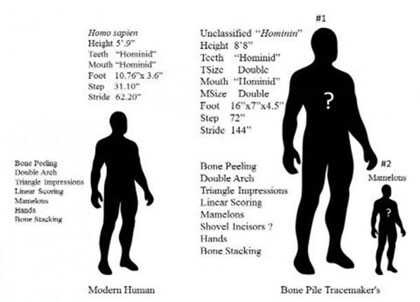 Conclusions image from Mills and Townsend 2016. (Author provided)
Conclusions image from Mills and Townsend 2016. (Author provided)
Comprehensive Bigfoot Investigations Required
As we emerge full circle, once again we are faced with the central question of why mainstream science has failed to comprehensively examine the possible existence of what some people refer to as Bigfoot. Credible multi-disciplinary evidence continues to emerge from unlikely places, yet in general it has failed to attract the professional scientific attention it deserves. By conducting this type of transparent research, writing a paper, and presenting it at a prestigious academic conference we hope to encourage deeper analysis of our own conclusions as well as inspire further scientific attention into the questions that surround the possibility of a giant, unclassified hominin living and thriving in the Pacific Northwest .
Our research has provided a place to begin for those willing to take up the task and put credible evidence to the test. At the end of the day why are we still asking the same question: “is Bigfoot real”? We encourage the scientific community to move beyond their skepticism in order to conduct deep examination of our efforts as well as that of others in this emerging area of research. Science has an obligation by definition to explain the unexplained, whatever that may be. By presenting our conclusions at a prestigious anthropological research conference and authoring this article I hope to highlight a place where researchers can start.
Top image: Why is the scientific community still stuck on asking “is Bigfoot real” rather than conducting scientific analysis of the evidence. Source: ginettigino / Adobe Stock
By Mitchel N. Townsend
More on the Animal Mutilation Issue and the Secret Surveillance of the U.S. Cattle Herd
By Nick Redfern
WELL, my two recent articles on cattle mutilations, and how aliens have zero to do with them, provoked a number of people to state that I was wrong. No, I was not wrong. One person said, over at Facebook, that landing markings are never found at the site of mutilations. That’s total garbage. As is the claim made to me that black helicopters are never seen at mutilation sites. They certainly are seen. Not only that, and as you’ll see, one of the key figures in this controversy came around to the theory that the mutilations were the work of a top secret government program. How do we know that? From the official FBI records and U.S. police files on the subject. And, for those who disagreed with me, take a look at those same files. Thanks to the Freedom of Information Act, the files have been in the public domain for years. They can be found at this link at the FBI’s website, The Vault. In August 1975, Senator Floyd K. Haskell, of Colorado, made his voice known to the FBI, on the growing cattle mutilation controversy: “In Colorado’s Morgan County area there has also been reports that a helicopter was used by those who mutilated the carcasses of the cattle, and several persons have reported being chased by a similar helicopter. Because I am gravely concerned by this situation, I am asking that the Federal Bureau of Investigation enter the case.”
Officer Gabe Valdez of Rio Arriba County, New Mexico came to a fascinating theory – and it had absolutely nothing to do with aliens. On the matter of whether or not the mutilations were the work of cults or natural predators, Valdez said: “Both have been ruled out due to expertise and preciseness and the cost involved to conduct such a sophisticated and secretive operation. It should also be noted that during the spring of 1974 when a tremendous amount of cattle were lost due to heavy snowfalls, the carcasses had been eaten by predators. These carcasses did not resemble the carcasses of the mutilated cows. Investigation has narrowed down to these theories which involve (1) Experimental use of Vitamin B12 and (2) The testing of the lymph node system. During this investigation an intensive study has been made of (3) What is involved in germ warfare testing, and the possible correlation of these 3 factors (germ warfare testing, use of Vitamin B12, testing of the lymph node system).”
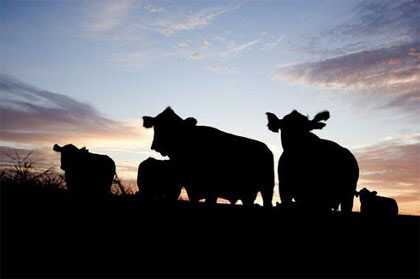 A lengthy document, prepared by Forrest S. Putman, the FBI’s Special-Agent-in-Charge at Albuquerque, New Mexico was soon thereafter sent to the FBI’s headquarters in Washington, D.C. It read: “Information furnished to this office by Officer Valdez indicates that the animals are being shot with some type of paralyzing drug and the blood is being drawn from the animal after an injection of an anti-coagulant. It appears that in some instances the cattle’s legs have been broken and helicopters without any identifying numbers have reportedly been seen in the vicinity of these mutilations. Officer Valdez theorizes that clamps are being placed on the cow’s legs and they are being lifted by helicopter to some remote area where the mutilations are taking place and then the animal is returned to its original pasture. The mutilations primarily consist of removal of the tongue, the lymph gland, lower lip and the sexual organs of the animal.”
A lengthy document, prepared by Forrest S. Putman, the FBI’s Special-Agent-in-Charge at Albuquerque, New Mexico was soon thereafter sent to the FBI’s headquarters in Washington, D.C. It read: “Information furnished to this office by Officer Valdez indicates that the animals are being shot with some type of paralyzing drug and the blood is being drawn from the animal after an injection of an anti-coagulant. It appears that in some instances the cattle’s legs have been broken and helicopters without any identifying numbers have reportedly been seen in the vicinity of these mutilations. Officer Valdez theorizes that clamps are being placed on the cow’s legs and they are being lifted by helicopter to some remote area where the mutilations are taking place and then the animal is returned to its original pasture. The mutilations primarily consist of removal of the tongue, the lymph gland, lower lip and the sexual organs of the animal.”
The document continues: “Much mystery has surrounded these mutilations, but according to witnesses they give the appearance of being very professionally done with a surgical instrument, and according to Valdez, as the years progress, each surgical procedure appears to be more professional. Officer Valdez has advised that in no instance, to his knowledge, are these carcasses ever attacked by predator or scavenger animals, although there are tracks which would indicate that coyotes have been circling the carcass from a distance. Special Agent Putman then informed the Director of the outcome of Valdez’s run-ins with officials. He also advised that he has requested Los Alamos Scientific Laboratory to conduct investigation for him but until just recently has always been advised that the mutilations were done by predatory animals. Officer Valdez stated that just recently he has been told by two assistants at Los Alamos Scientific Laboratory that they were able to determine the type of tranquilizer and blood anti-coagulant that have been utilized.”
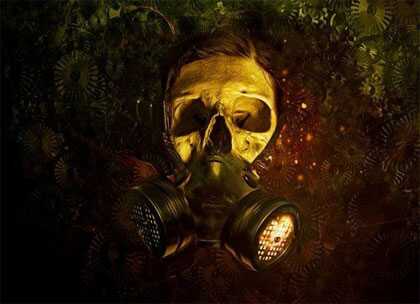 And, finally, there’s one fascinating piece of information to think about. The Durango Herald, in 2014, ran an article that covered all manner of weirdness in the area. Here’s one of the most important parts of the story: “Valdez…appeared on the History Channel’s UFO Hunters in 2009. He revealed images: disturbing mutilations of cattle and what he claimed was a human hybrid found inside a cow. He also said he found gas masks and even a ballpoint pen at scenes.” For those who think cattle mutilations are the work of aliens, then why are they using gas masks (yes, more than one)? The idea that creatures from other worlds would use regular gas masks – of our making – during the mutilations is both ridiculous and totally hilarious. And pretty sad for those caught in an “I want to believe” mode. Wake up! MU
And, finally, there’s one fascinating piece of information to think about. The Durango Herald, in 2014, ran an article that covered all manner of weirdness in the area. Here’s one of the most important parts of the story: “Valdez…appeared on the History Channel’s UFO Hunters in 2009. He revealed images: disturbing mutilations of cattle and what he claimed was a human hybrid found inside a cow. He also said he found gas masks and even a ballpoint pen at scenes.” For those who think cattle mutilations are the work of aliens, then why are they using gas masks (yes, more than one)? The idea that creatures from other worlds would use regular gas masks – of our making – during the mutilations is both ridiculous and totally hilarious. And pretty sad for those caught in an “I want to believe” mode. Wake up! MU
Why Cattle Mutilations Aren’t the Work of Aliens
By Nick Redfern
THERE was a time when I thought it was at least feasible that cattle mutilations might be the work of aliens. That, however, was more than a few years ago. The more I dug into the mystery, the more I came to believe that the subject had far less to do with aliens and far more to do with government activity. Within in the field of Ufology, there is an acceptance that the first real animal mutilation case (as ufologists see it) was that of Snippy, a horse found dead under bizarre coincidences. As the Denver Library state of the Snippy affair: “On September 7, 1967, near the town of Alamosa in the San Luis Valley, Snippy, a 3-year-old Appaloosa, failed to return to the Harry King Ranch where she was stabled. Two days later, Mr. King (the ranch owner) discovered Snippy’s remains roughly a quarter-mile from the ranch house. According to his account, the neck and head had been completely stripped of flesh, leaving nothing but bare, seemingly sun-bleached, white bone, while the remainder of the mare remained unscathed.”
The problem here is not the story, but the fact that the more I dug into the matter of the mutilations, the more I came to find that secret government studies of the United States’ cattle herds had been going on for decades. In fact, way back. The reason: the U.S. government was quite rightly very worried about foreign nations and agents using deadly viruses to bring the herd down and, as a result, cause chaos in America. So, the government – periodically and careful and quietly – ran tests on cattle to see how such attacks on the U.S. were working or not on the poor animals. If that disappoints you, too bad. And if you think that such a thing couldn’t be done, consider the data contained in the documents I’m about to share with you now. It was back in 2001, while spending about in the National Archives, that I found out the extent to which government agencies were secretly tied to America’s cattle.
 Bacteriological Warfare in the United States is a fascinating FBI document – declassified into the public domain via the terms of the Freedom of Information Act – that covers the years 1941 to 1950. Notably, of the file’s original 1,783 pages, no less than 1,074 have been firmly withheld from declassification by the FBI. The file reveals a wealth of illuminating and disturbing data on animal disease and death, and their potential, theoretical links to bacteriological warfare and sabotage by enemy nations and individuals. For example, J.R. Ruggle, the FBI Special-Agent-in-Charge at the Savannah, Georgia office of the Bureau in the early-to-mid 1940s, wrote thus to FBI Director J. Edgar Hoover on February 3, 1943: “This office has received a copy of a communication from John T. Bissell, Colonel, General Staff, Assistant Executive Officer, Military Intelligence Service, Washington, D.C., dated December 29, 1942, to directors of intelligence in all Service commands…” Colonel Bissel’s communication read:
Bacteriological Warfare in the United States is a fascinating FBI document – declassified into the public domain via the terms of the Freedom of Information Act – that covers the years 1941 to 1950. Notably, of the file’s original 1,783 pages, no less than 1,074 have been firmly withheld from declassification by the FBI. The file reveals a wealth of illuminating and disturbing data on animal disease and death, and their potential, theoretical links to bacteriological warfare and sabotage by enemy nations and individuals. For example, J.R. Ruggle, the FBI Special-Agent-in-Charge at the Savannah, Georgia office of the Bureau in the early-to-mid 1940s, wrote thus to FBI Director J. Edgar Hoover on February 3, 1943: “This office has received a copy of a communication from John T. Bissell, Colonel, General Staff, Assistant Executive Officer, Military Intelligence Service, Washington, D.C., dated December 29, 1942, to directors of intelligence in all Service commands…” Colonel Bissel’s communication read:
“It has been brought to the attention of this division the possibility in the immediate future of an attempt on the part of the enemy to plant bombs containing germs or to endeavor to create an epidemic, such as hoof and mouth disease, among cattle and other livestock. It is requested that should any information concerning the above come to the attention of the Directors of Intelligence of the Service Commands or the A.C. of S. [Assistant Chief of Staff], G-2 [Army Intelligence], Western Defense Command, that the same be transmitted by the most expeditious means to the Assistant Chief of Staff, G-2 War Department.” And what did the government do? I’ll tell you: they very carefully began to take a look at the cattle herd and to determine the extent to which those “enemy nations and individuals” might be. And the secret investigations were undertaken wherever it seemed the cattle were being subjected to viruses by our enemies.
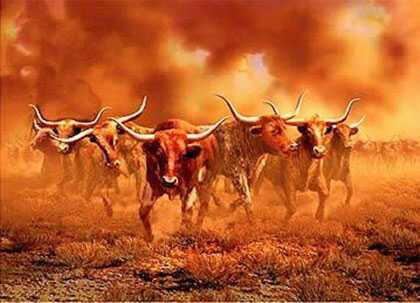 The FBI even found examples of such concerns going back to the First World War: “Anton Dilger, a German-American medical graduate from John Hopkins University, was in Germany when the First World War broke out. He offered his services to the Kaiser, and was promptly detailed by Colonel Nicolai to do secret service work in the United States. Dilger returned to America with a supply of cultures of glanders and anthrax germs. Financed by von Papen, he set up a laboratory in Chevy Chase, near Washington, and started breeding germs on a large scale for infecting mules, horses, and cattle awaiting shipment to the allies. This man then organized a band of some twelve assistants to travel around the country, carrying Dilger’s germs in small glass phials stopped with corks through which a needle extended. This roving band jabbed their deadly needles into the livestock. They also spread germs by placing them in fodder and drink. Thousands of soldiers, as well as horses and cattle, died as a result of Dilger’s germs. At last Dilger revolted against his mission of silent death. He was murdered by German spies a few months before the end of the war. Could it happen here? It did happen here!”
The FBI even found examples of such concerns going back to the First World War: “Anton Dilger, a German-American medical graduate from John Hopkins University, was in Germany when the First World War broke out. He offered his services to the Kaiser, and was promptly detailed by Colonel Nicolai to do secret service work in the United States. Dilger returned to America with a supply of cultures of glanders and anthrax germs. Financed by von Papen, he set up a laboratory in Chevy Chase, near Washington, and started breeding germs on a large scale for infecting mules, horses, and cattle awaiting shipment to the allies. This man then organized a band of some twelve assistants to travel around the country, carrying Dilger’s germs in small glass phials stopped with corks through which a needle extended. This roving band jabbed their deadly needles into the livestock. They also spread germs by placing them in fodder and drink. Thousands of soldiers, as well as horses and cattle, died as a result of Dilger’s germs. At last Dilger revolted against his mission of silent death. He was murdered by German spies a few months before the end of the war. Could it happen here? It did happen here!”
Now, let’s take a trip to 1949. Particularly notable is a July 11, 1949 document that refers to the government’s desire to acquire “world-wide information on animal diseases and animal population” [italics mine]. And, one year later, the FBI was still collecting such data. On October 19, 1950, the FBI prepared a document titled Abnormal Loss of Hogs in Nebraska and Illinois that dealt with an unusually high number of hog deaths in the aforementioned states – as a result of cholera. The files, however, make it clear that, in official, FBI quarters, the nature of the animals’ deaths had been viewed with deep suspicion. It was concluded that the deaths were due to a “variant virus” or “atypical virus”” that stemmed from “local conditions and the physical conditions of the hogs.” The important factor, however, is that this document was found within a file specifically focused upon bacteriological warfare. In other words, the FBI was still looking closely at any and all animal deaths that might not have wholly conventional explanations.
So, we’ve seen that government concerns went back the First World War. Then, in the late 1940s the secret investigations were still going on. And, as was shown above, secret investigations of hogs in the 1950s took place. Then, a decade later, cattle mutilations began. I could have made this article at least a 4-part one, such is the sheer number of documents now available on the subject (if you know where to look). There are thousands and thousands of pages. Had cattle mutilations suddenly surfaced out of nowhere in 1967, I might be a bit more open to the alien angle. The fact is, though, that covert studies of America’s cattle have been going on for around a century. Sometimes with the bodies of the dead left where they were covertly studied. Add to that a bit of government disinformation to the effect that all of this is due to aliens, then it’s very easy to see how government agencies were able to undertake their secret studies and with the real (and far more disturbing) story kept hidden. MU
